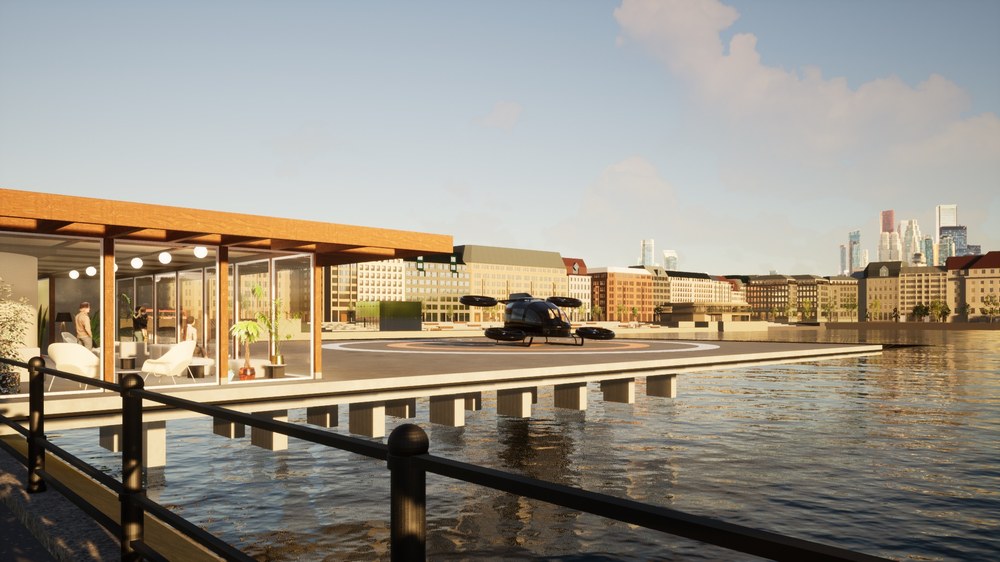Vertiport Management

The term “vertiport”, also called “vertidrome”, describes ground infrastructure used by Vertical Takeoff and Landing (VTOL) aircraft. Vertiports can be fully equipped with parking and charging spots and might additionally offer maintenance, repair and overhaul services. The functional design and the technical equipment of vertiports and vertiport networks are both a challenge and a key driver for the operational deployment of air taxis, as well as the provision of urban air mobility (UAM) services.
The recent DLR research on vertiports in the HorizonUAM project included the design and operation of individual vertiports on a micro-level, but also extended to the macrolevel by addressing vertiport airspace network management and network optimization. Moreover, DLR studied the opportunities and challenges of integrating air taxi services and vertiport operations into an airport environment, thus controlled airspace, and introduced the approach of developing a UAM model city in order to validate our concepts in scaled flight trials.

Air taxis on approach – The DLR-project HorizonUAM
Your consent to the storage of data ('cookies') is required for the playback of this video on Youtube.com. You can view and change your current data storage settings at any time under privacy.
Management concepts and procedures for vertidromes
DLR researchers investigated potential management concepts and procedures for conflictfree airspace operations. One of the concepts was based on direct routes between vertiports represented as four dimensional trajectories. A second concept made use of a rigid route structure and timeslot management. Exemplarily, 20 vertiports within the city of Hamburg were considered in the networks. Average travel time savings of up to 43% compared to ground-based transportation could be reached.
In addition to urban airspace, vertiport network capacity is a critical resource of the UAM network that, if optimised, can reduce the required vertiport infrastructure and fleet size to a minimum. For the exemplary Hamburg network, a commuter scenario with 2,800 missions per day was set up. Simulation results showed that a fleet of 275 vehicles is required to operate all 2,800 missions. When assuming that batteries are swapped instead of recharged, the required fleet size could be reduced to 225 vehicles (19 %), also resulting in 24 % less parking positions required.
Challenges to air traffic control
Integrating vertiports at an existing airport poses a challenge to air traffic control (ATC). Adding air taxis to the traffic flow results in additional airspace users with performance characteristics rather different from conventional fixedwing traffic. Hence, the goal should be to provide them with takeoff and landing spaces independent of the runway system, and with favorable independent arrival and departure routes.
The control task itself should be designed in a way that the responsible air traffic controllers can maintain their situation awareness, and that the potential increase in workload remains feasible. DLR tested the tactical part of the defined processes for the integration of air taxis for feasibility in realtime simulations in DLR’s Apron and Tower Simulator with ten air traffic controllers for the reference use case Hamburg airport. In addition to conventional traffic in a peak hour including 44 movements per hour, fifteen air taxis were added per onehour simulation run. Air taxi routes were visualised and active routes were highlighted on the radar screen in order to support controllers in their tasks. In addition, since air taxis are strongly exposed to the risk of wildlife strike due to the flight and performance characteristics of air taxis, information about critical bird movement in the area was displayed on the screen.
Vertidrome layout and surface features
The number and arrangement of pads, stands and taxi ways can vary. To evaluate the airside performance of a specific vertiport layout, DLR developed an assessment framework, named Vertiport Airside Level of Service (VALoS). VALoS considers different stakeholder perspectives (e. g. air taxi operator, passenger, and vertiport operator) and offers the opportunity to quantify a qualitative vertiport design in strategic planning phases. The VALoS rating can be used to evaluate the performance of a specific vertiport configuration for a given performance target and demand distribution.
Vertidrome management tool
During the HorizonUAM project, DLR developed a prototypical vertiport management tool to demonstrate the scheduling and sequencing of air taxi flights. The vertiport manager is fully integrated within Uspace and receives realtime information on flight plans, including requests for start and landing and emergency notifications. Additional information coming from other Uspace services (e. g. weather information) can be accessed on request. DLR demonstrated the integration in a scaled flight test environment with multicopters (< 15 kg) representing passenger-carrying air taxis.
Further projects for safe and integrated UAM operations
Beyond this work in the HorizonUAM project, the DLR Institute of Flight Guidance is actively developing the future of urban or innovative air mobility through several complementary projects. The EUREKA project with DLR involvement focuses on the integration of this topic into existing airspace structures and develops scalable and safe traffic management concepts tailored to urban environments. In parallel, the DLR-internal IAM-OSA project (Innovative Air Mobility – Operational Safety Assessment) is tackling the question of operational safety in complex urban scenarios. It introduces new methodologies for risk analysis and safety evaluation, supporting the safe deployment of UAM services. Another key initiative is VERTIFIED, which addresses the certification and operational readiness of vertiport infrastructure. VERTIFIED develops tools and procedures to validate the performance and safety of ground facilities for VTOL operations under real-world conditions. Furthermore, DLR supports industry research in the European project EUREKA where U-space services at vertiports are under investigation.
All these projects are closely interconnected, creating important synergies in terms of knowledge sharing and technical development. By this, DLR aims to build a comprehensive ecosystem that supports the safe, efficient, and scalable implementation of UAM in future airspace.
